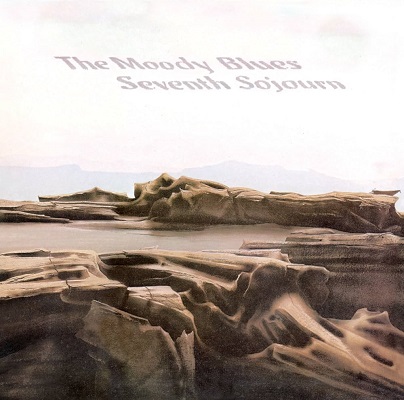In November 1972, the Moody Blues released Seventh Sojourn, their aptly named seventh album. At the time, rock was becoming an extremely complex palette on which to navigate and excel. In the wake of the Moodies’ transcendental stirrings, bands like ELP, Yes, Jethro Tull and Pink Floyd were releasing spellbinding records of their own. How ironic that the Moodies themselves were simply winding down, preparing to remove themselves from the landscape in the midst of their greatest popularity. For not only would Seventh Sojourn become the band’s first number one in America; the simultaneous re-release of the five-year-old “Nights In White Satin” would propel demand for the group beyond all expectations.
The Moody Blues began their long career as an R&B band, with Denny Laine and Clint Warwick front and center. Shortly after the mega-hit “Go Now” and album of the same name, Laine and Warwick exited, leaving a vacancy in the band. Their shoes were capably filled by Justin Hayward and John Lodge, and the Moody Blues’ sound dramatically shifted. Beginning with 1967’s Days Of Future Passed, the Moodies mounted a cozy campaign over the course of seven classic albums. At one point, they were the most successful band in the world. But the five members of the band were also staunch individualists in the truest sense of the word. Hayward and Lodge were and remain the principal songwriters. Ray Thomas: also a writer and diverse instrumentalist. Drummer Graeme Edge filled in the gaps with poetry. Mike Pinder not only co-founded the group; he wrote many of the band’s more cerebral pieces and brought in the Mellotron, an instrument that gave the Moody Blues their cosmic glow. Even as the Seventh Sojourn sessions were oiled with tension brought on by years of incessant recording, touring and vying for space, the magic sound and execution is undeniably there. With unmistaken charm, Seventh Sojourn marked the end of the Moody Blues’ most fervent phase.
Pinder dots the song list with two space-age numbers: “Lost In A Lost World” and “You’re A Free Man”; Hayward builds on the momentum of “Nights In White Satin” with the breezy assuage of “New Horizon” and “the Land Of Make-Believe” while lacing the melody with some inspiring guitar work and vocal harmonies on “You and Me.” Thomas sings a brisk tale of life at sea on “For My Lady.” Lodge fills out the disc with the album’s best-known tracks, “Isn’t Life Strange” and “I’m Just A Singer (In A Rock And Roll Band).” The Moody Blues would tour behind Seventh Sojourn for almost two years. While it nestled at the top of the album chart, “Nights In White Satin” re-entered the singles charts and made its way into the Top Ten. Upon completion of the tour in 1974, the Moodies went on hiatus for three years.
When the five resurfaced in 1978 with Octave, the reception was lukewarm when compared to their previous seven releases. Prior to Octave‘s forthcoming tour, Pinder left the group for good and The Moody Blues successfully carried on, losing Thomas, who left the group in 2002 and passed away in 2018, and then Edge, who died in 2021, effectively ending the Moody Blues. Fortunately, the legend of Seventh Sojourn and the previous six albums — collectively, the Classic 7 — lives on for generations to come.
~ Shawn Perry




















